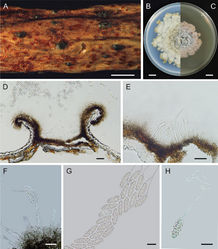Nagrajomyces laojunshanensis
| Notice: | This page is derived from the original publication listed below, whose author(s) should always be credited. Further contributors may edit and improve the content of this page and, consequently, need to be credited as well (see page history). Any assessment of factual correctness requires a careful review of the original article as well as of subsequent contributions.
If you are uncertain whether your planned contribution is correct or not, we suggest that you use the associated discussion page instead of editing the page directly. This page should be cited as follows (rationale):
Citation formats to copy and paste
BibTeX: @article{Zhuo2022MycoKeys93, RIS/ Endnote: TY - JOUR Wikipedia/ Citizendium: <ref name="Zhuo2022MycoKeys93">{{Citation See also the citation download page at the journal. |
Genus: Nagrajomyces
Name
Nagrajomyces laojunshanensis C. L. Hou & L. Zhuo sp. nov. – Wikispecies link – Pensoft Profile
Etymology
The epithet laojunshanensis refers to the location where the type specimen was collected.
Type
China, Yunnan Province, Lijiang, Laojunshan, 26°39'44"N, 99°46'58"E, alt. 2910 m, on living twigs of Rhododendron cinnabarinum Hook. f., 20 June 2021, coll. C.L. Hou, M.J. Guo, H. Zhou (holotype CAF 800049). Ex-type culture CFCC 58177.
Diagnosis
This new species differs from N. fusiformis by conidia that are elongate-elliptical, blunter at both ends, and usually 3-septate and larger. Nagrajomyces laojunshanensis differs from N. dictyosporus by conidiomata that are unilocular and without stalks.
Description
Conidiomata solitary, pycnidial, unilocular, subglobose to ellipsoidal, subepidermal in origin, immersed at first, then becoming erumpent, 218–406 μm wide, 188–275 μm high, peridia black, 37–43 μm thick, opening irregularly in the upper part, with faint yellow content. Conidiophores ampulliform, smooth, hyaline, multiguttulate, 16.0–25.5 × 2–4 μm (x̄ = 21 × 3 μm, n = 20). Conidia elongate-elliptical, 1–3-septate, mostly 3-septate, smooth, hyaline, 18–23 × 5.5–7.0 μm (x̄ = 19.5 × 6.5 μm, n = 20), with a long, whip-like appendage at the tip of each conidium, 70–200 μm (x̄ = 143.5 μm, n = 20) in length. Sexual morph not observed.
Culture characteristics
Cultures (ex-type CFCC 58177) on PDA 8 cm diameter after 1 month, with irregular margins, sparse aerial mycelium, colonies with whitish margins, with center turning black olive (#3b3c36) with increasing age. On MEA, 5.7 cm diameter after 1 month, with irregular margins, colonies with beaver (#9f8170) -colored margins, with center turning black olive (#3b3c36) with increasing age. Conidia not observed.
Additional specimen examined
China, Yunnan province, Kunming, Luquan, Jiaozixueshan, 26°05'04"N, 102°50'54"E, alt. 3823 m, on living twigs of Rhododendron cinnabarinum Hook. f., 23 June 2021, coll. C.L. Hou, M.J. Guo, H. Zhou, (BJTC 1849).
Notes
Nagrajomyces laojunshanensis differs from N. dictyosporus by conidia that are colorless and conidiomata that are without stalks. Nagrajomyces laojunshanensis differs from N. fusiformis by elongate-elliptical conidia with blunter ends, which are longer (18–23 μm vs. 13–19 μm) and wider (5.7–7.0 μm vs. 2.8–3.7 μm). Conidia of N. laojunshanensis are mostly 3-septate, whereas those of N. fusiformis are 1-septate. Molecular sequence data confirm the presence of two distinct species.
Original Description
- Zhuo, L; Guo, M; Wang, Q; Zhou, H; Piepenbring, M; Hou, C; 2022: A new study of Nagrajomyces: with two new species proposed and taxonomic status inferred by phylogenetic methods MycoKeys, 93: 131-148. doi
Images
|

